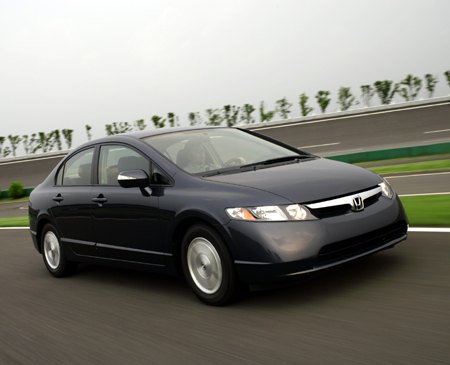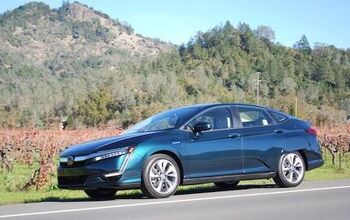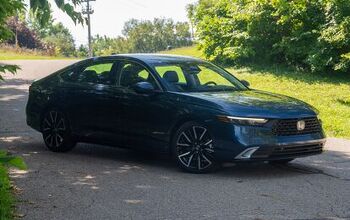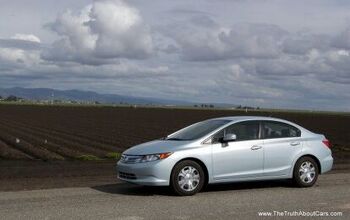Honda Civic Hybrid Review
In the waning years of the twenty first century, when the world's petroleum reserves finally near exhaustion, hydrogen fuel cells will most likely propel our personal transportation. These cars of the future will be practical, safe, fuel efficient, clean-running and dull. The gas – electric Honda Civic Hybrid (HCH) could well be the prototype for this new breed of automobile; where all the car's harmful social and environmental byproducts have been minimized, and all the fun of driving has been designed out of existence.
Strangely enough, the HCH's exterior isn't dreary. From some angles, you could even call it rakish. While this site has criticized the Civic's severely tilted windscreen, I consider the HCH's near-horizontal glasshouse a welcome bit of drama on an otherwise conventional shape. The details are equally well-judged. In a world of cars with enormous projector beam headlamps, the HCH's eyes are dignified and restrained. And the sedan's rear– complete with its all-important hybrid badge– is as handsome as the Audi sedans it slavishly copies.
The HCH's interior is cutting edge contemporary– provided you set the Way Back machine to 1973. The cabin's [petroleum-based] plastics are well-formed and satisfying to the touch, but their omnipresence soon becomes oppressive. Seat adjustments are few (what happened to the lumbar support?) and our tester's fabric covers reminded me of the great mass velour extinctions of the late Disco Era. The HCH's raked windscreen places so much dash in front of you that only the protruding speedo prevents drivers from developing horizontal vertigo. Although the distance to the window creates an illusion of unlimited space, the HCH's cabin is no larger than a standard small car's.
The HCH's music system plays all manner digital files with faithful reproduction– which is just as well. The sound helps mask the stripped-down car's endless road roar. The navigation system listens attentively, understands your commands intuitively and reacts appropriately. If you need to find the closest Korean restaurant to Topeka, Kansas, it dutifully directs you to drive 1560 miles to Los Angeles for dinner. The one toy we expected to see– some kind of hi-tech Prius-like readout showing battery power regeneration– takes the form of a relatively pedestrian digital display on the left of the gigantic tacho.
Twist the HCH's key and there is little reward, just a quiet hum. Tipping the progress pedal unleashes an initial surge of acceleration– that immediately tails off to a slow canter. Woe to the operator whose accelerative expectations are calibrated to vehicles born during the days of cheap and plentiful fossil fuel. While driving an HCH in traffic, a sextant may prove useful. A call down to the engine room brings varying pitched moaning sounds depending upon how much one's ears can tolerate. Regardless, the rate of acceleration remains fairly constant and completely relaxed.
While the brakes get credit for recharging the HCH's battery pack, pressing the stoppers feels like you've lowered a wooden beam onto the tarmac. Panic stops are. The HCH's slender tires amplify this worrying non-effect in the rain. The Honda hybrid's handling will appeal mostly to those experienced in the two-man bobsled; there's plenty of roll and slippage through the turns. Driving the HCH at highway speeds is also a challenge; any kind of incline drives the CVT transmission crazy. There is simply no way to maintain a constant pace without resorting to cruise control. Even then, the tach ascends to 6000 rpm or more when mounting significant grades.
Of course, no one buys an HCH because they like to drive. They want excellent gas mileage (and the right to solo in California's high occupancy vehicle lanes). In 1400 miles of mixed urban and highway driving, I filled the tank three times. The first time, there were only few miles on the odometer. I didn't expect much in the way of economy and still calculated 43 miles per gallon. With the second tank, I tried harder to conserve fuel. I was rewarded with 47 miles per gallon. By the third tank, I'd lost all interest in economy and just wanted to get the test drive over and done with– and still wound up getting 47 miles per gallon.
The HCH may be the perfect car for fuel misers, but it only offers pistonheads one major advantage: it's so unrewarding to drive fast that you eventually give-up and drive under the speed limit. Of course, when you do that, it's win – win – win. You're helping to save the earth. You're making the safety Nazis happy. And you're protecting your driver's license. Of course, a slowly-driven Honda hybrid also blocks people who love to drive, and drive fast. But don't worry. One way or another, they're doomed. Yes, I've driven the future. It's safe, clean, frugal and tedious.
More by Jay Shoemaker
Latest Car Reviews
Read moreLatest Product Reviews
Read moreRecent Comments
- Bd2 Lexus is just a higher trim package Toyota. ^^
- Tassos ONLY consider CIvics or Corollas, in their segment. NO DAMNED Hyundais, Kias, Nissans or esp Mitsus. Not even a Pretend-BMW Mazda. They may look cute but they SUCK.I always recommend Corollas to friends of mine who are not auto enthusiasts, even tho I never owed one, and owned a Civic Hatch 5 speed 1992 for 25 years. MANY follow my advice and are VERY happy. ALmost all are women.friends who believe they are auto enthusiasts would not listen to me anyway, and would never buy a Toyota. They are damned fools, on both counts.
- Tassos since Oct 2016 I drive a 2007 E320 Bluetec and since April 2017 also a 2008 E320 Bluetec.Now I am in my summer palace deep in the Eurozone until end October and drive the 2008.Changing the considerable oils (10 quarts synthetic) twice cost me 80 and 70 euros. Same changes in the US on the 2007 cost me $219 at the dealers and $120 at Firestone.Changing the air filter cost 30 Euros, with labor, and there are two such filters (engine and cabin), and changing the fuel filter only 50 euros, while in the US they asked for... $400. You can safely bet I declined and told them what to do with their gold-plated filter. And when I changed it in Europe, I looked at the old one and it was clean as a whistle.A set of Continentals tires, installed etc, 300 EurosI can't remember anything else for the 2008. For the 2007, a brand new set of manual rec'd tires at Discount Tire with free rotations for life used up the $500 allowance the dealer gave me when I bought it (tires only had 5000 miles left on them then)So, as you can see, I spent less than even if I owned a Lexus instead, and probably less than all these poor devils here that brag about their alleged low cost Datsun-Mitsus and Hyundai-Kias.And that's THETRUTHABOUTCARS. My Cars,
- NJRide These are the Q1 Luxury division salesAudi 44,226Acura 30,373BMW 84,475Genesis 14,777Mercedes 66,000Lexus 78,471Infiniti 13,904Volvo 30,000*Tesla (maybe not luxury but relevant): 125,000?Lincoln 24,894Cadillac 35,451So Cadillac is now stuck as a second-tier player with names like Volvo. Even German 3rd wheel Audi is outselling them. Where to gain sales?Surprisingly a decline of Tesla could boost Cadillac EVs. Tesla sort of is now in the old Buick-Mercury upper middle of the market. If lets say the market stays the same, but another 15-20% leave Tesla I could see some going for a Caddy EV or hybrid, but is the division ready to meet them?In terms of the mainstream luxury brands, Lexus is probably a better benchmark than BMW. Lexus is basically doing a modern interpretation of what Cadillac/upscale Olds/Buick used to completely dominate. But Lexus' only downfall is the lack of emotion, something Cadillac at least used to be good at. The Escalade still has far more styling and brand ID than most of Lexus. So match Lexus' quality but out-do them on comfort and styling. Yes a lot of Lexus buyers may be Toyota or import loyal but there are a lot who are former GM buyers who would "come home" for a better product.In fact, that by and large is the Big 3's problem. In the 80s and 90s they would try to win back "import intenders" and this at least slowed the market share erosion. I feel like around 2000 they gave this up and resorted to a ton of gimmicks before the bankruptcies. So they have dropped from 66% to 37% of the market in a quarter century. Sure they have scaled down their presence and for the last 14 years preserved profit. But in the largest, most prosperous market in the world they are not leading. I mean who would think the Koreans could take almost 10% of the market? But they did because they built and structured products people wanted. (I also think the excess reliance on overseas assembly by the Big 3 hurts them vs more import brands building in US). But the domestics should really be at 60% of their home market and the fact that they are not speaks volumes. Cadillac should not be losing 2-1 to Lexus and BMW.
- Tassos Not my favorite Eldorados. Too much cowbell (fins), the gauges look poor for such an expensive car, the interior has too many shiny bits but does not scream "flagship luxury", and the white on red leather or whatever is rather loud for this car, while it might work in a Corvette. But do not despair, a couple more years and the exterior designs (at least) will sober up, the cowbells will be more discreet and the long, low and wide 60s designs are not far away. If only the interiors would be fit for the price point, and especially a few acres of real wood that also looked real.





































Comments
Join the conversation
Way off base on the report...I've driven this car and it drives nothing like what you say. I think you drove this car thinking it's a SI sports car when it's not made for it. But it still feels like a regular Civic EX Sedan which, by all accounts, feels pretty good and solid and safe. I won't put a 70 mph speed dash through the cones but to slam it because it doesn't and call it the FUTURE?? This is Honda's interpretation of the future...or immediate future option. Who said driving an ecomomical, fuel frugal car has to be boring? I just don't get that mentality.
Ok, I'm a "Piston Head" owning a 1973 Challenger (340=6 MPG), 1969 Charger RT/SE (440MAG = 5 MPG), and a Lincoln Navigator 4X4 (10 MPG). What's funny is I just bought a 2008 Honda Civic Hybird. What's even funnier is I live in Michigan! This "Piston Head" finds the Civic Hybird enjoyable to drive. It's a bit challenging navigating the Detroit Freeway system, but not because it's an import, but rather I feel real small among the SUV's, Semi traffic, and pot holes more like Moon craters. My Civic Hybird averages 32 MPG in cold weather (30 degrees and less), but managed 38 MPG on the HWY doing 70 MPH (still a bit slow for Detroit). I admit the Civic's performance is not impressive, but I choose it over the Prius only because I wanted to drive a fuel efficient vehicle that looked like a car and not an enviornmental statement. I will never drive my Civic in heavy snows because I'm told the plastic skid plates on the undercarriage are designed for areodynamics and would probably get ripped off, so I'll park it in the garage and drive the big gun Navigator (10 MPG). Yes, I love to drive big, fast, 8cyl vehicles, but at $3.00 (+) a gallon for gas, I'm learning to reserve the need for speed for short weekend drives. If I was asked to rate my Civic Hybird on a scale 1 to 10, I would rate it an 8 for comfort, drivability, handeling, Safety, and fuel economy. But no one asked me to rate it! The Civic Hybird does what it's designed to do; save fuel and reduce our carbon footprint. No I'm not a tree hugger....yet!